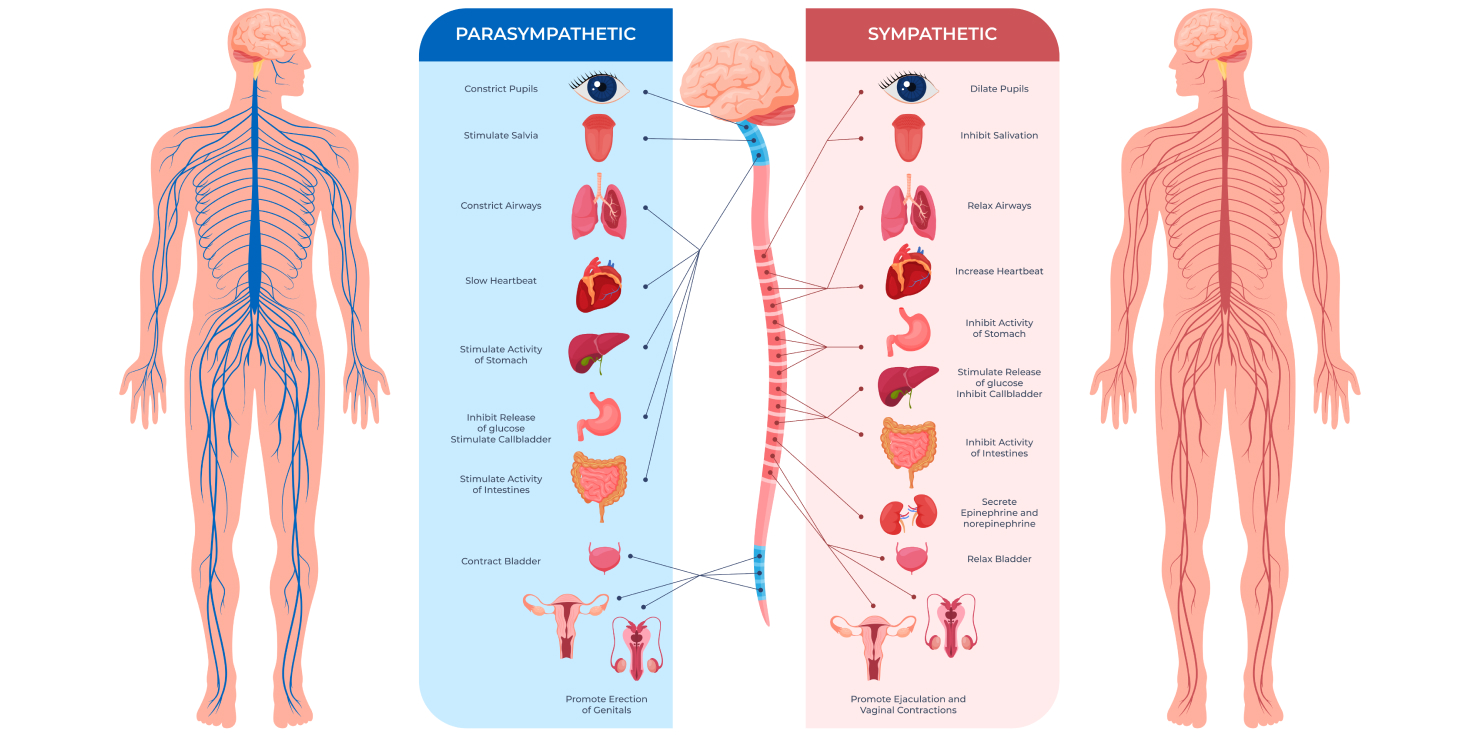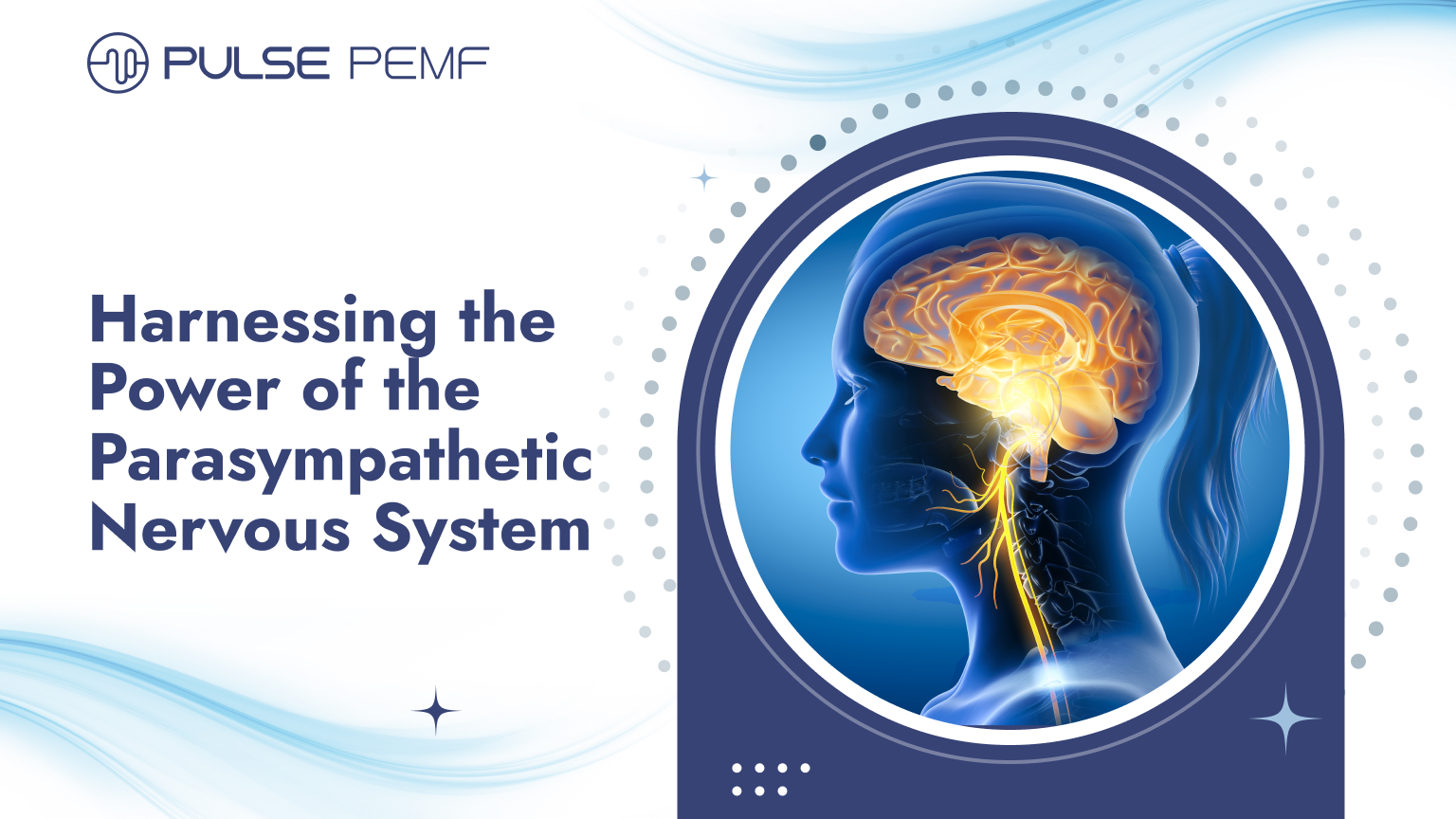Feeling stressed? Ever wished you could hit a built-in “relax” button?
In this blog, we’re exploring the body’s natural calming system, the parasympathetic nervous system, and how you can harness its power to feel your best.
We’ll guide you through simple ways to activate this calming system and promote overall well-being. Let’s get started!
The Symphony of Your Nervous System

Our bodies are like amazing orchestras, with countless systems working together in harmony. One of the most important conductors is the nervous system, which controls everything from our thoughts and movements to our digestion and heart rate. The nervous system has two main sections:
The sympathetic nervous system: This is our “gas pedal”, kicking us into high gear during stressful situations. It’s great for short bursts of energy, but constant activation can leave us feeling on edge.
The parasympathetic nervous system: This is the “brake pedal.” This system promotes relaxation, digestion, and cell repair. It’s like hitting the pause button to allow our bodies to recharge.
For optimal health, we need a balanced symphony between these two systems. When the “fight-or-flight” response takes over for too long, it can lead to health problems. Let’s delve deeper into the parasympathetic nervous system, its mechanisms and benefits, and how to unlock its potential for deeper relaxation.
Introducing the PSNS: Your Relaxation and Recovery System
Here’s a closer look at how the parasympathetic nervous system functions:
Key Components of the PSNS
Imagine a complex communication network. The PSNS has three main control centers:
Vagus Nerve: This is the main nerve of your parasympathetic nervous system. This system controls specific involuntary body functions such as digestion, heart rate, and immune system.
Cranial Nerves: These nerves originate from your brainstem and control functions like tear production and saliva flow.
Sacral Spinal Cord: Nerves from this area manage functions like urination and bowel movements.
How the PSNS Works
The PSNS uses special chemical messengers called neurotransmitters to talk to your organs. These neurotransmitters tell your body to slow down, allowing you to:
- Relax: Your heart rate slows, and your breathing becomes deeper.
- Digest: Your digestive system gets to work, breaking down food for energy.
- Repair: Your body focuses on healing and rebuilding tissues.
Role of PSNS in the Autonomic Nervous System
The PSNS and the sympathetic nervous system are part of the autonomic nervous system, which controls functions we don’t consciously think about. This constant dance between the two systems maintains a state called homeostasis, which means your body’s internal environment stays balanced. When the parasympathetic nervous system is strong, it can counteract the effects of stress and promote overall well-being.
PEMF has emerged as an effective modality for supporting the parasympathetic nervous system. It uses electromagnetic pulses to stimulate our cells, helping them function better overall.
In the following sections, we’ll explore how PEMF might help you unlock the power of your parasympathetic nervous system to experience deeper relaxation and improved well-being.
PSNS Activation for Physical and Mental Well-being
A strong parasympathetic nervous system is a key player in maintaining overall health and well-being. Here’s how activating your relaxation response can benefit you:
Reduced Anxiety and Depression

When the PSNS activates, it acts like a natural stress reliever. Your heart rate slows, your breathing deepens, and your body releases fewer stress hormones like cortisol. This cascade of calming effects translates to feeling more relaxed and less anxious.
Improved Digestion
The PSNS stimulates gut motility, the movement of food through your digestive system, allowing for efficient nutrient absorption. Chronic stress and sympathetic dominance, on the other hand, can disrupt this delicate balance, leading to digestive issues like constipation or bloating. By activating the PSNS, we can help our digestive system function optimally.
Cardiovascular Health
Chronic stress and high blood pressure are risk factors for heart disease. The PSNS may help by lowering your heart rate and blood pressure, reducing the strain on your cardiovascular system.
PSNS Activation for Cognitive Function and Immunity
The benefits of a strong parasympathetic nervous system extend beyond relaxation and digestion. Let’s see how the PSNS can enhance your cognitive function and immune system.
Improved Mental Clarity and Focus
Chronic stress and a dominant sympathetic nervous system can be like having a million tabs open on your brain’s browser. This can lead to difficulty focusing, forgetfulness, and impaired decision-making. When the PSNS activates, it helps to quiet the mental chatter and allows for better information processing. Think of it as hitting the refresh button on your brain, promoting mental clarity, focus, and cognitive flexibility.
Enhanced Immune Function
There’s a close link between your nervous system and your immune system. A balanced nervous system, with a healthy PSNS influence, supports the body’s ability to fight off infections and illness. Here’s how:
Reduced Inflammation: Chronic stress can lead to chronic inflammation, a root cause of many health problems. The PSNS helps regulate inflammatory responses, creating a more favorable environment for your immune system to function optimally.
Improved Sleep: Sleep is vital for immune function. The PSNS may promote deeper, more restorative sleep, allowing your body to repair and regenerate better.
Relaxation Techniques to Enhance PSNS Activity
Now that we understand the power of the parasympathetic nervous system, let’s explore some techniques to activate it and experience its amazing benefits.
Deep Breathing Exercises
Deep, diaphragmatic breathing is a powerful tool for activating the parasympathetic nervous system. Here’s how you could get started:
- Find a comfortable position, sitting or lying down.
- Place one hand on your stomach and the other on your chest.
- Breathe in slowly through your nose, feeling your belly rise (not your chest).
- Hold your breath for a count of 1-2.
- Exhale slowly through pursed lips, feeling your stomach sink.
- Repeat for 5-10 minutes, focusing on your breath and feeling your body relax with each exhale.
Try incorporating deep breathing exercises before, during, or after your PEMF session. The combination may further activate the parasympathetic nervous system system and enhance your relaxation experience.
Progressive Muscle Relaxation
This technique involves tensing and relaxing different muscle groups to release tension throughout your body. Here’s a step-by-step guide:
- Sit or lie down comfortably. Close your eyes and take a few deep breaths.
- Start with your toes: Curl your toes tightly for a count of 5, then release and feel the tension melt away.
- Move up your body: Tense and relax different muscle groups one at a time, focusing on major muscle groups.
- After tensing and relaxing each muscle group, take a deep breath and allow yourself to sink deeper into relaxation.
Progressive muscle relaxation can be particularly effective before a PEMF session, helping you release tension and prepare your body for deeper relaxation.
Mindfulness and Meditation Practices

Mindfulness meditation and guided meditations are excellent tools for quieting the mind and activating the parasympathetic nervous system. There are many different meditation techniques available online and through apps. Even a few minutes of daily meditation can significantly improve your ability to manage stress and promote relaxation.
The calming environment created during PEMF sessions can be a perfect opportunity to incorporate brief mindfulness practices or guided meditations. Focus on your breath, sensations in your body, or positive affirmations to enhance your relaxation experience.
PEMF Therapy
PEMF’s pulsed electromagnetic fields interact with cellular processes, potentially promoting relaxation and reducing stress by activating the PSNS.
Combining PEMF with the relaxation techniques mentioned above can create a powerful one-two punch for activating your PSNS and promoting overall well-being.
Lifestyle Habits for PSNS Harmony
Your lifestyle choices can significantly impact your parasympathetic nervous system function. By incorporating healthy habits into your daily routine, you can promote relaxation, improve sleep quality, and boost your overall well-being.
For a deeper dive into how to optimize your lifestyle for PSNS health, check out our blog post “[Lifestyle Changes That Can Transform Your PSNS Health]”. This blog post will explore various lifestyle habits that can support a healthy parasympathetic nervous system and unlock its full potential for relaxation and well-being.
Conclusion
By incorporating the relaxation techniques and lifestyle practices mentioned above, along with Pulse PEMF, you can take control of your parasympathetic nervous system. This may unlock its amazing potential for relaxation, stress reduction, and overall well-being.
Ready to experience the power of PEMF? Contact us today to learn more about our PEMF devices and how they can help you activate your PSNS and achieve deeper states of peace and relaxation!












